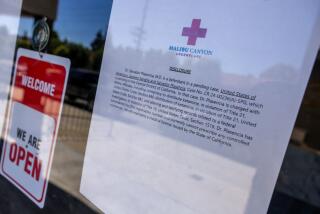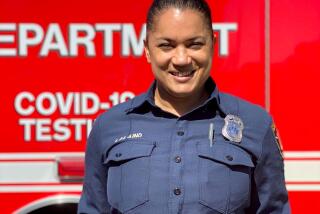Drawings on Patient List Cited in Probe
GLENDALE — Hospital officials are investigating whether a “frowning face” drawn next to names on a list of failing patients was a signal to or from Efren Saldivar, the hospital worker who confessed to killing 40 to 50 people and then recanted, one of his former colleagues said.
Ursula Anderson, a respiratory therapist who worked for three years with Saldivar on the night shift at Glendale Adventist Medical Center, also said Friday that hospital investigators are focusing on a night when four people died at the hospital during Saldivar’s shift.
Anderson, who was fired without explanation by the hospital April 3, said she was unable to answer the questions and believes that she and three other respiratory care workers let go by the hospital are being used as scapegoats and unfairly painted as participants in alleged wrongdoing.
“I’ve never done anything wrong,” Anderson said. “I’m upset. I’m very upset.”
Anderson gave her account of last month’s questioning by hospital officials in a case that has prompted international news coverage and hundreds of phone calls from relatives worried that their loved ones may have been killed by a man who allegedly described himself as an “angel of death.”
Saldivar told television interviewers this week that he “lied” during his statements to police, and denied killing anyone. He has not been charged with any crime. Glendale police said they believe at least one homicide may have occurred.
Hospital officials reiterated that they were cooperating with police and declined to comment because of the ongoing investigation. Police also declined to comment on Anderson’s remarks, other than to say that she was being investigated along with the other workers laid off from the hospital.
Sgt. Rick Young, spokesman for the Glendale Police Department, declined to comment on Anderson’s role in the investigation. “We can’t confirm or deny anything,” Young said.
Anderson said that, just days before she was fired, she was questioned for more than an hour by an attorney and other investigators working for the hospital. Some of the questions, she said, focused on a frowning face that was drawn next to some names of patients on an assignment board in the respiratory care unit that posted medical directions.
Anderson said the attorneys wanted to know whether the faces--drawn with Xs as eyes and a tongue sticking out of a down-turned mouth--were directions from someone else to Saldivar.
The attorney “asked me if it was a sign for [Saldivar] to go see the patient,” said Anderson, 30, who has been a therapist for nine years.
Anderson, who interpreted the symbol as a gallows-humor signal that a patient had died, said attorneys also asked whether the symbol was left by Saldivar as a signature mark to show that he had “paid that person a visit.”
“I just thought it meant that someone had died,” Anderson said.
Hospital investigators also asked her whether she could remember a night when four people died during the shift she shared with Saldivar, she said. Anderson said she did not.
The investigators asked whether she knew how Saldivar was able to obtain drugs--Pavulon and succinylcholine chloride--that in his confession he told police he had used, she said. Respiratory care therapists at the hospital have no access to such drugs, she said, adding that she believed, if Saldivar obtained such medication, someone must have helped.
“There’s no way we could get those sort of meds,” she said.
Saldivar first came under suspicion after hospital officials received a tip in April 1997. A statistical investigation cleared him, though the hospital assigned three employees to monitor Saldivar’s activities.
The most recent investigation began after the hospital received another tip in February this year that they turned over to police.
Anderson said she believes she is the original source for the February tip. She said she told a friend about an incident involving Saldivar in which a patient was accidentally overmedicated, causing a near-death reaction. She thinks the friend later told hospital officials. Anderson said she didn’t tell her supervisors because the patient was later revived and fully recovered.
That account contrasts with a police affidavit that says a tipster indicated that Saldivar had “helped a patient die fast” on Feb. 16, 1998. Police declined to comment on the source of the tip.
Police questioned Anderson briefly at the hospital, then more extensively 10 days later, she said.
She said the police didn’t ask her about specific incidents, but wanted to know details about Saldivar’s activities.
She said that hospital nurses sometimes joked how their patients would die when Saldivar was around but said that she took the jibes to be more of the dark humor common among professionals who work around death.
Anderson’s firing notification, reviewed by The Times, shows a check by a box labeled “Other” as a reason for her firing.
“Terminated after internal investigation and advise from legal counsel,” reads the explanation at the bottom of her form, which was signed by her supervisor, John Bechthold. Reached at the hospital, Bechthold said he didn’t want to comment.
Anderson said she is especially upset that she has been fired after she fully cooperated with police. Her annual evaluations, also reviewed by The Times, show that she consistently received average or above average marks for her performance.
Anderson said she thinks she was fired because she didn’t report rumors to her superiors. That, she thinks, is unfair.
“I never harmed any patients. I loved my work,” Anderson said.
More to Read
Sign up for Essential California
The most important California stories and recommendations in your inbox every morning.
You may occasionally receive promotional content from the Los Angeles Times.










